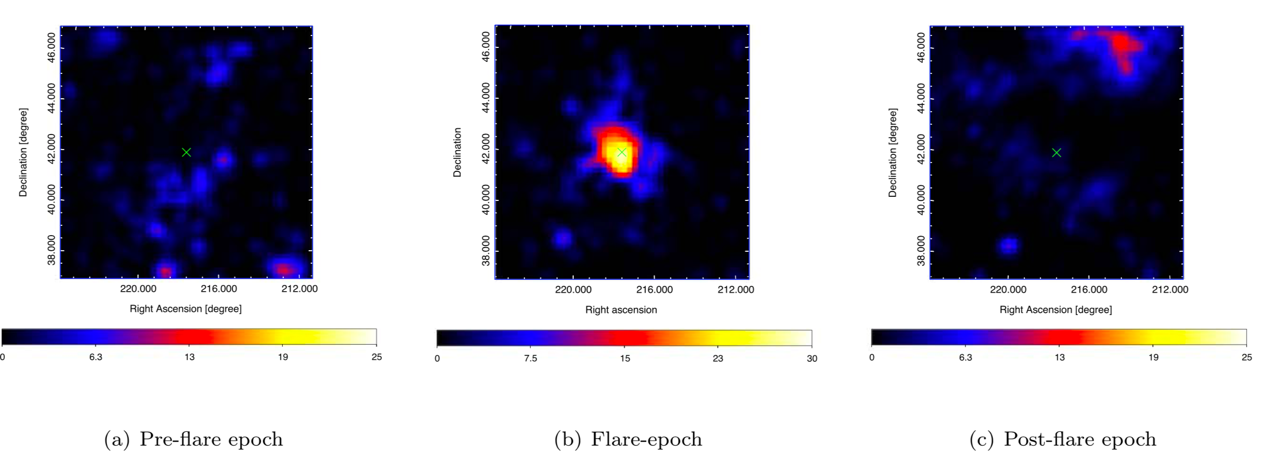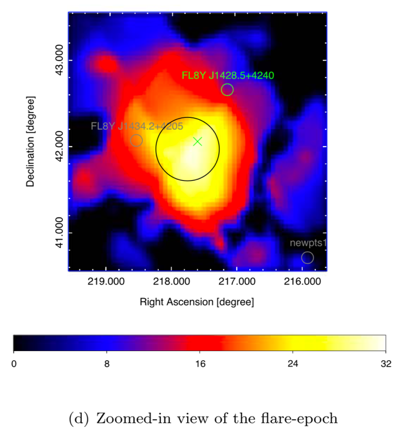Dr. LIAO Nenghui and his colleagues at the Purple Mountain Observatory (PMO) of the Chinese Academy of Sciences discovered a promising candidate of most distant GeV gamma-ray source based on an analysis of Fermi-LAT1 data. Their findings were published inthe Astrophysical Journal Letters.(http://iopscience.iop.org/article/10.3847/2041-8213/aae20d) Blazars, an extreme subclass of Active Galactic Nuclei (AGN) whose strong relativistic jets point along our line-of-sight, have been found to be the most numerous gamma-ray populations in our sky. Gamma-ray emission from distant blazars can not only reliably probe the innermost region of the supermassive black holes but also put a severe constraint on the extragalactic background light models of the early universe. However, detection of the weak gamma-ray emission of very-distant blazars is rather challenging. Only seven gamma-ray blazars were previously reported to be at a redshift beyond z=3, with the farthest one at z=4.3. A systematic analysis of Fermi-LAT data of these seven sources by the same group revealed significant long-term gamma-ray variabilities in five of them (published in the Astrophysical Journal), suggesting that the very distant blazars may be relatively easier to be detected in gamma-ray in an outburst phase. Inspired by these results, the researchers have tried to analyze the ~9 years of time-resolved Fermi-LAT data of B3 1428+422, a blazar at z=4.72. Though no significant GeV signal displays for the entire 110-month averaged data, a strong new gamma-ray transient in this direction emerged in a 10-month period (see Figure 1). The new transient gamma-ray source is far away from the Galactic plane and has a rather soft spectrum, in agreement with being a high redshift blazar. Within the localization error radius of the new gamma-ray transient there is no other suitable high-energy emission source candidate. So far the most distant GeV source detected by Fermi-LAT is a Gamma-ray burst GRB 080916C, at a photometric redshift of 4.35. Therefore, B3 1428+422 is a promising candidate to break the record to be the farthest high-energy gamma-ray source detected so far. A formal association of the GeV transient with B3 1428+422 will be established with future simultaneous multi-frequency observations in the period of the high gamma-ray activity of the new transient. Finding more of such distant gamma-ray blazars will provide crucial information that can be used to constrain models of how supermassive black holes formed in the early universe. The study was supported by the National Natural Science Foundation of China. 

By with LIAO Nenghui Fig. 1: The significances of the GeV emission in the direction of B3 1428+422 at different epochs. The black circle represents the 95% C.L. γ-ray error radius and the green cross is the radio position of B3 1428+422. Fermi-LAT: the Large Area Telescope (LAT) on board the Fermi Gamma-ray Space Telescope. |
